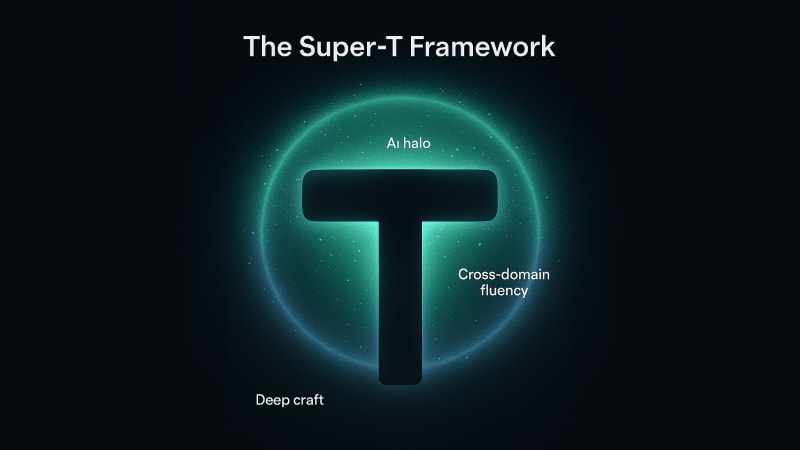That's a bold title, but it's high time we call it what it is: the age of the super-T product person.
For years, product teams have hidden behind silos. PMs wrote PRDs. Designers Figma'd. Engineers coded. Marketers waited for updates. That world is gone. AI has dissolved the walls and forced us all to learn just enough of everything to be dangerous.
TL;DR
The next generation of product teams won't be made of isolated specialists. They'll be composed of curious, AI-augmented generalists who can think like systems, jump between disciplines, and turn an idea into a working prototype before lunch.
The why
Silos were efficient in a pre-AI world. Division of labor made sense when information moved slowly, and tools required years of expertise. But now, anyone can spin up an LLM, feed it market research, write a spec, generate design concepts, and scaffold an app in the same morning.
The product world has shifted from hand-offs to loops. Context is now the real superpower. The ability to zoom out and connect insights across business, design, and engineering makes the difference between reactive product work and strategic invention.
The how
Let's make it tangible.
Picture a PM vibing an idea with an LLM. They describe a problem, iterate on user stories, refine scope, and by the end of the chat, have a detailed PRD, a task list, and even example API endpoints. They feed that to a prototyping agent that generates a working UI. By lunch, the team is discussing real interactions, not wireframes.
That's the super-T workflow: a deep core skill (say, product strategy) combined with broad AI-assisted literacy across design, tech, and storytelling. It's not about replacing specialists. It's about understanding the system well enough to guide it fluidly.
To operate this way, teams need three shifts:
- Tool fluency over tool ownership. You don't have to be a Figma expert, but you need to move inside it comfortably enough to communicate intent.
- Systemic thinking over linear processes. Instead of sequential steps (research → design → build), think in feedback loops where AI fills in the gaps.
- AI as connective tissue. Use LLMs, visual generators, and orchestration tools not just for speed, but for better context-sharing across disciplines.
The Super-T Framework
If the traditional T-shaped model showed depth in one area and breadth across others, the Super-T adds a connective layer of AI-assisted intelligence that magnifies both.
Visualize it like this:
- The vertical bar still represents your deep craft—product strategy, design, or engineering.
- The horizontal bar represents cross-domain fluency—understanding the workflows, incentives, and constraints of other disciplines.
- The AI halo around the T is what makes it super: it accelerates learning, automates translation between domains, and amplifies decision-making.

In practice, a Super-T person:
- Uses AI to move faster across the horizontal bar (gaining context across functions).
- Uses AI to go deeper down the vertical bar (expanding mastery in their core craft).
- Connects people, ideas, and tools through shared context, not just documentation.
When teams are filled with Super-Ts, they start operating as systems instead of pipelines. Everyone can initiate, contribute, and adapt because the connective intelligence layer makes boundaries permeable.
Challenges
It's not all sunshine and speed runs.
Cross-disciplinary work introduces friction. Who owns quality? How do you avoid superficial “AI mashups” that look good but lack depth? The answer lies in culture, not just capability. You need trust, shared language, and humility to learn from each other.
AI amplifies curiosity but also exposes ignorance fast. The best super-Ts embrace that. They use AI as a mirror, constantly testing assumptions and deepening their understanding of the whole product system.
Concluding
The super-T era isn't about becoming a polymath overnight. It's about using AI to stretch your T-shaped skills wider and deeper, connecting what used to be separate.
The teams that win will be those who see AI not as a productivity hack, but as the glue that turns individuals into systems thinkers.
This is the new shape of product.
Frequently asked questions
What is a "super-T" product person?
A "super-T" product person combines deep expertise in one area with broad knowledge across others, using AI to connect disciplines and make faster, smarter decisions.
How does AI enable this new kind of product work?
AI tools remove traditional boundaries by helping people design, write, code, and analyze faster, turning context-switching into an advantage instead of a burden.
Does this mean specialists are obsolete?
Not at all. Specialists remain critical, but the most effective teams combine deep skill with broad, AI-augmented curiosity across roles.


